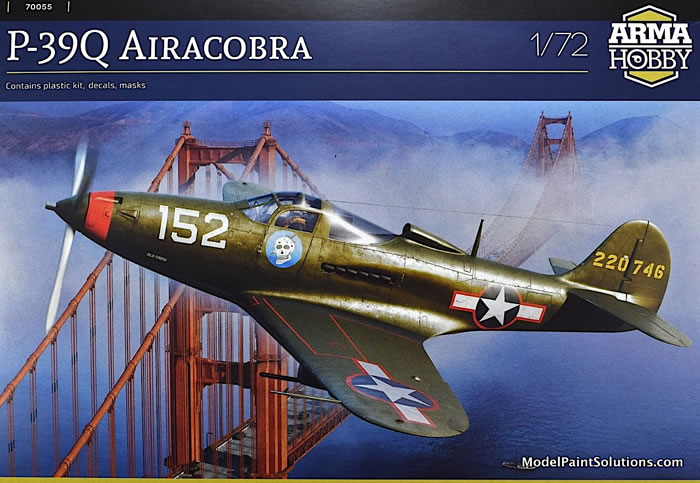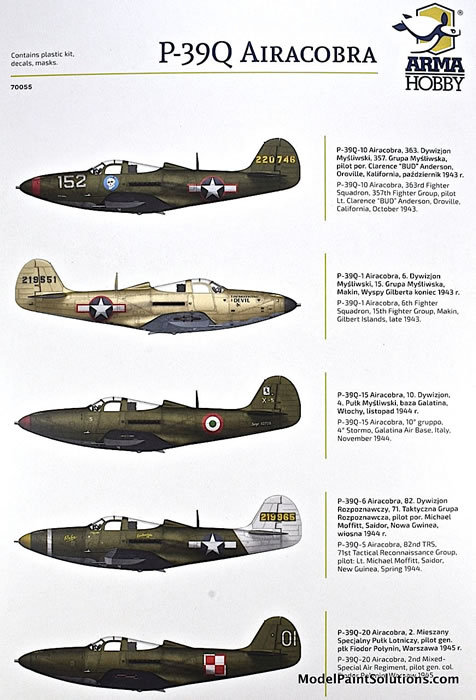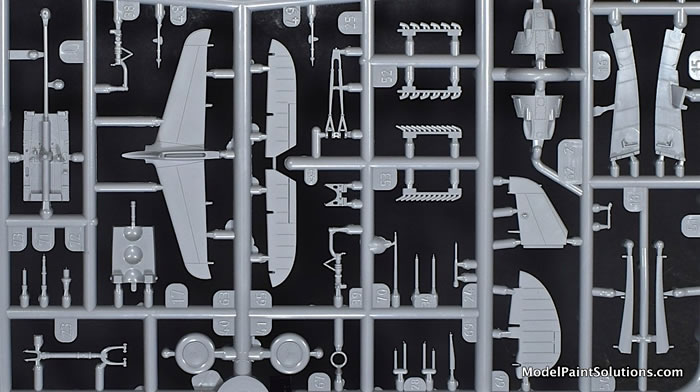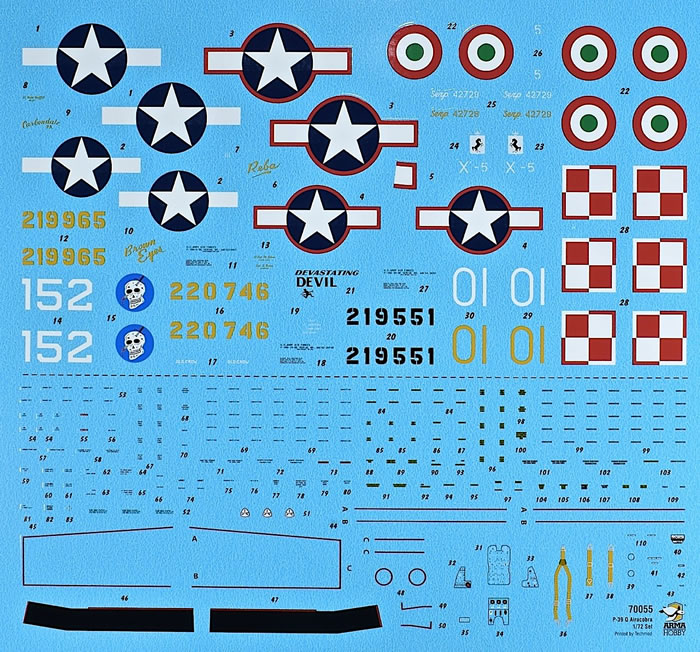P-39Q Airacobra

Arma Hobby, 1/72 scale
S
u m m a r y : |
Description and Item No.: |
Arma Hobby Kit No. 70055 - P-39Q Airacobra |
Contents and Media: |
81 injection moulded plastic parts (not all are used), 5 clear parts, and one decal sheet with markings and airframe stencils for 5 schemes. |
Price: |
€26.50 plus shipping available online at Arma Hobby
£26.60 UK Price (£22.17 Export Price) Plus Shipping at Hannants
and hobby retailers worldwide |
Scale: |
1/72 |
Review Type: |
First Look |
Advantages: |
The recessed surface details are crisp and scale appropriate with little-to-no flash. The kit has small, well-placed sprue-attach points, clear canopy parts, simple and conventional engineering, and a surprisingly low parts count. Quality decals are provided for 5 colorful schemes. |
Disadvantages: |
None noted. |
Recommendation: |
This is another beautiful kit with simple engineering and quality decals that will build into a very nice model right out of the box. Highly Recommended! |
Reviewed by John Miller

Background
The Bell P-39 Airacobra is a fighter produced by Bell Aircraft for the United States Army Air Forces during WWII. It was one of the principal American fighters in service when the United States entered combat.
The P-39 was used by the Soviet Air Force, and enabled individual Soviet pilots to collect the highest number of kills attributed to an U.S. fighter type flown by any air force in any conflict. Other major users of the type included the Free French, the Royal Air Force and the Italian Co-Belligerent Air Force.

It had an unusual layout, with the engine installed in the center fuselage, behind the pilot, and driving a tractor propeller in the nose with a long shaft. It was also the first fighter fitted with a tricycle undercarriage. Although its mid-engine placement was innovative, the P-39 design was handicapped by the absence of an efficient turbo-supercharger preventing it from performing high-altitude work. For this reason it was rejected by the RAF for use over western Europe but adopted by the USSR, where most air combat took place at medium and lower altitudes. Together with it’s derivative the P-63 Kingcobra, the P-39 was one of the most successful fixed-wing aircraft manufactured by Bell.
(Text and Photos Edited from Wikipedia)
Introduction:
First, a disclaimer: I’m a fan of ARMA Hobby kits. So much so, they’re available on my site. These folks make some of the most detailed and well-engineered 1/72 scale kits this modeler has seen. Their most recent offering not only out-classes every other P-39 kit in the one true scale, it continues a long line of kits that have set a new standard for 1/72 scale models.
The kit is conveyed on two light grey sprues. The parts have small attachment points positioned to facilitate damage-free removal. As usual for an ARMA kit, there is very little flash to contend with: very nice.
As usual, construction begins with the multi-part cockpit and as with their previous offerings, ARMA managed to cram the details of a 1/48th scale cockpit into a 1/72 scale model. All one need do is build the cockpit right out of the box and you’ll be rewarded with an amazingly detailed result.
The next steps entail construction of a multi-piece nose wheel bay that builds onto the front of the cockpit tub. Once this is complete, nose weight, in the form of three, steel ball bearings, is added to a tray in front of the instrument panel with depressions to accommodate the bearings; very nice, indeed. There will be no worries of this kit being a tail-sitter when complete. After the cockpit-nose wheel well assembly is trapped between the fuselage halves, the instructions direct the builder to remove (fill and blend) a small access panel on the starboard nose cowl.
Next up is assembly of the beautifully detailed wing. Should one want to hang stores under the wings, holes will have to be drilled ahead of time; a diagram is provided showing where and how many. After the left and right upper wing halves are joined to the full span lower wing, the builder is directed to fill two gun ports on the leading edges of both the left and right wings (4 total). In addition to the gun ports, builders are instructed to remove (fill and blend) three, small circular access panels under the tip of the starboard wing.

With the fuselage joined to the assembled wing, next in sequence is the horizontal stabilizer and elevator; both single-pieces. The amazing surface detail on these parts deserves comment as do the elevator hinges; beautiful. The empennage is finished off by the addition of a single-piece vertical stabilizer and nicely detailed rudder.
The gear are next in sequence and here too the detail is more than abundant for this scale. Of note is the intricate and detailed nose gear brace that will look very convincing under paint and a wash. The nose and main wheels/tires are single piece with the attach points arranged on the slightly flattened (weighted) portion of the tire; nice. The gear assembly is completed by the addition of the main gear wheel well doors, each with individual actuators; nice, again.

The canopy parts are crisply molded and crystal clear. The doors are beautifully molded in clear and with a little work can be posed open. You can bet the doors on mine will be open:) Die cut masks of Tamiya-tape-like material are provided making what could be a challenging masking job quite easy.

The build is finished up by the addition of the nicely molded propeller and hub as well as vent covers and underwing stores in the form of drop tanks, gun gondolas, and bombs. Note that some of these finishing parts are scheme-specific so study the instructions carefully.
Marking Options
The very nice decal sheet, printed by Techmod, provides markings and stencil data for 5 colorful schemes.

Of note are the ample airframe stencils; one of the most comprehensive for this scale I’ve seen.
The schemes covered are as follows:
-
P-39Q-10 Airacobra, 363rd Fighter Group, 357th Squadron, Oroville, CA, 1943. Pilot: Clarence “Bud” Anderson.
-
P-39Q-1 Airacobra, 6th Fighter Squadron, 15th Fighter Group, Makin, Gilbert Islands, 1943.
-
P-39Q-15 Airacobra, 10 Gruppo, 4 Stormo, Galatina Airbase, Italy, November, 1944.
-
P-39Q-5 Airacobra, 82nd TRS, 71st Tactical Reconnaissance Group, Saidor, New Guinea, 1944. Pilot: Lt. Michael Moffit.
-
P-39Q-20 Airacobra, 2nd Mixed-Special Air Regiment, Warsaw, 1945. Pilot: Gen. Col. Fiodor Polynin.
This is a an absolutely beautiful kit of a well-deserved subject. We’ve long needed an updated P-39 in the “one true scale” and the folks at ARMA have delivered. The inscribed surface details are ample and scale-appropriate. The cockpit detail is awesome right out of the box. The parts count is low, the engineering is simple, and quality decals decals covering 5 schemes seals the deal. What’s not to like?
Highly Recommended!
John
For more on this review visit Modelpaintsolutions.com.
Thanks to Arma Hobby for the sample
Review Text and Images Copyright © 2022 by John Miller / Model Paint Solutions
Page Created 28 October, 2022
Last updated
28 October, 2022
Back to HyperScale Main Page
Back to Reviews Page |
Home
| What's New |
Features |
Gallery |
Reviews |
Reference |
Forum |
Search